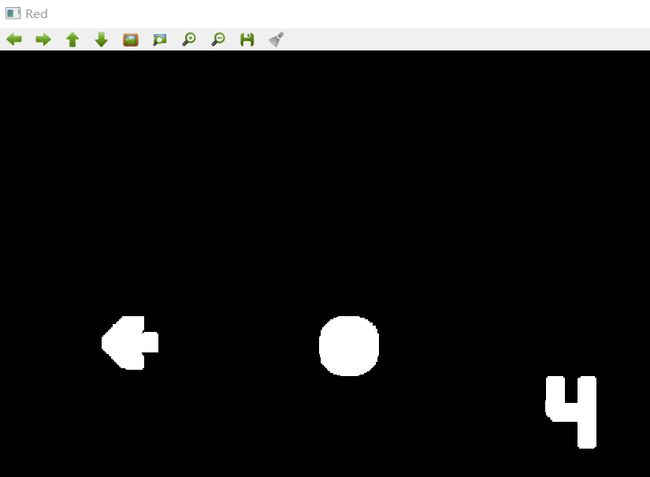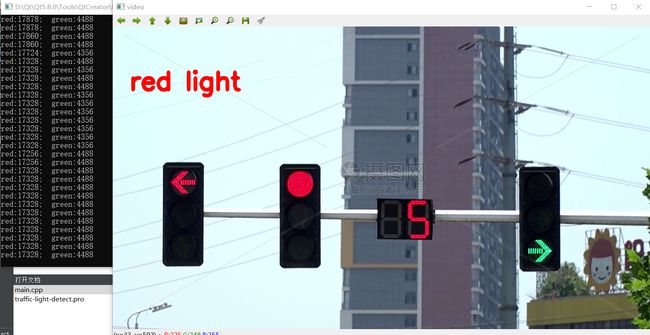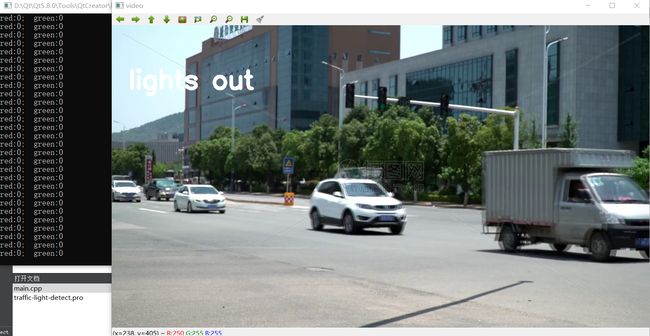【OpenCV】 红绿灯识别检测
目录
一:红绿灯识别检测效果展示
二:红绿灯识别检测具体步骤
1.初始化设置,对亮度设置 视频路径 进行初始化设置
2.帧处理,调整视频亮度,分解YCrCb的三个成分,拆分红和绿,对这两种颜色进行特征提取
3.腐蚀膨胀处理,去除其他噪点,提高红绿灯提取特征
4.红绿灯识别检测,给出识别结果显示
5.对红灯和绿灯进行轮廓提取
6.确定两个矩形区域是否相交
三: 红绿灯识别检测完整代码
一:红绿灯识别检测效果展示
使用到了OpenCV轮廓识别
如上图 轮廓识别 分别检测识别出红灯 绿灯 [检测出来的红灯轮廓和绿灯轮廓如下图所示]
在红绿灯都亮时,可以检测到数值
当红灯不亮 绿灯亮时,红灯没有数值 绿灯显示数值
当拍摄车辆通行,也就是红绿灯都不亮的时候,红灯绿灯都没有数值
二:红绿灯识别检测具体步骤
1.初始化设置,对亮度设置 视频路径 进行初始化设置
int redCount = 0;
int greenCount = 0;
Mat frame;
Mat img;
Mat imgYCrCb;
Mat imgGreen;
Mat imgRed;
// 亮度参数
double a = 0.3;
double b = (1 - a) * 125;
VideoCapture capture("D:/00000000000003jieduanshipincailliao/123.mp4");//导入视频的路径
if (!capture.isOpened())
{
cout << "Start device failed!\n" << endl;//启动设备失败!
return -1;
}2.帧处理,调整视频亮度,分解YCrCb的三个成分,拆分红和绿,对这两种颜色进行特征提取
// 帧处理
while (1)
{
capture >> frame;
//调整亮度
frame.convertTo(img, img.type(), a, b);
//转换为YCrCb颜色空间
cvtColor(img, imgYCrCb, CV_BGR2YCrCb);
imgRed.create(imgYCrCb.rows, imgYCrCb.cols, CV_8UC1);
imgGreen.create(imgYCrCb.rows, imgYCrCb.cols, CV_8UC1);
//分解YCrCb的三个成分
vector planes;
split(imgYCrCb, planes);
// 遍历以根据Cr分量拆分红色和绿色
MatIterator_ it_Cr = planes[1].begin(),
it_Cr_end = planes[1].end();
MatIterator_ it_Red = imgRed.begin();
MatIterator_ it_Green = imgGreen.begin();
for (; it_Cr != it_Cr_end; ++it_Cr, ++it_Red, ++it_Green)
{
// RED, 145 145 && *it_Cr < 470)
*it_Red = 255;
else
*it_Red = 0;
// GREEN 95 95 && *it_Cr < 110)
*it_Green = 255;
else
*it_Green = 0;
} 3.腐蚀膨胀处理,去除其他噪点,提高红绿灯提取特征
//膨胀和腐蚀
dilate(imgRed, imgRed, Mat(15, 15, CV_8UC1), Point(-1, -1));
erode(imgRed, imgRed, Mat(1, 1, CV_8UC1), Point(-1, -1));
dilate(imgGreen, imgGreen, Mat(15, 15, CV_8UC1), Point(-1, -1));
erode(imgGreen, imgGreen, Mat(1, 1, CV_8UC1), Point(-1, -1));
redCount = processImgR(imgRed);
greenCount = processImgG(imgGreen);
cout << "red:" << redCount << "; " << "green:" << greenCount << endl;4.红绿灯识别检测,给出识别结果显示
if(redCount == 0 && greenCount == 0)
{
cv::putText(frame, "lights out", Point(40, 150), cv::FONT_HERSHEY_SIMPLEX, 2, cv::Scalar(255, 255, 255), 8, 8, 0);
}else if(redCount > greenCount)
{
cv::putText(frame, "red light", Point(40, 150), cv::FONT_HERSHEY_SIMPLEX, 2, cv::Scalar(0, 0, 255), 8, 8, 0);
}else{
cv::putText(frame, "green light", Point(40, 150), cv::FONT_HERSHEY_SIMPLEX, 2, cv::Scalar(0, 255, 0), 8, 8, 0);
}
5.对红灯和绿灯进行轮廓提取
int processImgR(Mat src)
{
Mat tmp;
vector> contours;
vector hierarchy;
vector hull;
CvPoint2D32f tempNode;
CvMemStorage* storage = cvCreateMemStorage();
CvSeq* pointSeq = cvCreateSeq(CV_32FC2, sizeof(CvSeq), sizeof(CvPoint2D32f), storage);
Rect* trackBox;
Rect* result;
int resultNum = 0;
int area = 0;
src.copyTo(tmp);
//提取轮廓
findContours(tmp, contours, hierarchy, CV_RETR_CCOMP, CV_CHAIN_APPROX_SIMPLE);
if (contours.size() > 0)
{
trackBox = new Rect[contours.size()];
result = new Rect[contours.size()];
//确定要跟踪的区域
for (int i = 0; i < contours.size(); i++)
{
cvClearSeq(pointSeq);
// 获取凸包的点集
convexHull(Mat(contours[i]), hull, true);
int hullcount = (int)hull.size();
// 凸包的保存点
for (int j = 0; j < hullcount - 1; j++)
{
tempNode.x = hull[j].x;
tempNode.y = hull[j].y;
cvSeqPush(pointSeq, &tempNode);
}
trackBox[i] = cvBoundingRect(pointSeq);
}
if (isFirstDetectedR)
{
lastTrackBoxR = new Rect[contours.size()];
for (int i = 0; i < contours.size(); i++)
lastTrackBoxR[i] = trackBox[i];
lastTrackNumR = contours.size();
isFirstDetectedR = false;
}
else
{
for (int i = 0; i < contours.size(); i++)
{
for (int j = 0; j < lastTrackNumR; j++)
{
if (isIntersected(trackBox[i], lastTrackBoxR[j]))
{
result[resultNum] = trackBox[i];
break;
}
}
resultNum++;
}
delete[] lastTrackBoxR;
lastTrackBoxR = new Rect[contours.size()];
for (int i = 0; i < contours.size(); i++)
{
lastTrackBoxR[i] = trackBox[i];
}
lastTrackNumR = contours.size();
}
delete[] trackBox;
}
else
{
isFirstDetectedR = true;
result = NULL;
}
cvReleaseMemStorage(&storage);
if (result != NULL)
{
for (int i = 0; i < resultNum; i++)
{
area += result[i].area();
}
}
delete[] result;
return area;
}
int processImgG(Mat src)
{
Mat tmp;
vector > contours;
vector hierarchy;
vector< Point > hull;
CvPoint2D32f tempNode;
CvMemStorage* storage = cvCreateMemStorage();
CvSeq* pointSeq = cvCreateSeq(CV_32FC2, sizeof(CvSeq), sizeof(CvPoint2D32f), storage);
Rect* trackBox;
Rect* result;
int resultNum = 0;
int area = 0;
src.copyTo(tmp);
//提取轮廓
findContours(tmp, contours, hierarchy, CV_RETR_CCOMP, CV_CHAIN_APPROX_SIMPLE);
if (contours.size() > 0)
{
trackBox = new Rect[contours.size()];
result = new Rect[contours.size()];
// 确定要跟踪的区域
for (int i = 0; i < contours.size(); i++)
{
cvClearSeq(pointSeq);
// 获取凸包的点集
convexHull(Mat(contours[i]), hull, true);
int hullcount = (int)hull.size();
// 保存凸包的点
for (int j = 0; j < hullcount - 1; j++)
{
tempNode.x = hull[j].x;
tempNode.y = hull[j].y;
cvSeqPush(pointSeq, &tempNode);
}
trackBox[i] = cvBoundingRect(pointSeq);
}
if (isFirstDetectedG)
{
lastTrackBoxG = new Rect[contours.size()];
for (int i = 0; i < contours.size(); i++)
lastTrackBoxG[i] = trackBox[i];
lastTrackNumG = contours.size();
isFirstDetectedG = false;
}
else
{
for (int i = 0; i < contours.size(); i++)
{
for (int j = 0; j < lastTrackNumG; j++)
{
if (isIntersected(trackBox[i], lastTrackBoxG[j]))
{
result[resultNum] = trackBox[i];
break;
}
}
resultNum++;
}
delete[] lastTrackBoxG;
lastTrackBoxG = new Rect[contours.size()];
for (int i = 0; i < contours.size(); i++)
{
lastTrackBoxG[i] = trackBox[i];
}
lastTrackNumG = contours.size();
}
delete[] trackBox;
}
else
{
isFirstDetectedG = true;
result = NULL;
}
cvReleaseMemStorage(&storage);
if (result != NULL)
{
for (int i = 0; i < resultNum; i++)
{
area += result[i].area();
}
}
delete[] result;
return area;
} 6.确定两个矩形区域是否相交
//确定两个矩形区域是否相交
bool isIntersected(Rect r1, Rect r2)
{
int minX = max(r1.x, r2.x);
int minY = max(r1.y, r2.y);
int maxX = min(r1.x + r1.width, r2.x + r2.width);
int maxY = min(r1.y + r1.height, r2.y + r2.height);
if (minX < maxX && minY < maxY)
return true;
else
return false;
}三: 红绿灯识别检测完整代码
#include "opencv2/opencv.hpp"
#include "opencv2/imgproc.hpp"
#include
#include
using namespace std;
using namespace cv;
// Function headers
int processImgR(Mat);
int processImgG(Mat);
bool isIntersected(Rect, Rect);
// Global variables
bool isFirstDetectedR = true;
bool isFirstDetectedG = true;
Rect* lastTrackBoxR;
Rect* lastTrackBoxG;
int lastTrackNumR;
int lastTrackNumG;
//主函数
int main()
{
int redCount = 0;
int greenCount = 0;
Mat frame;
Mat img;
Mat imgYCrCb;
Mat imgGreen;
Mat imgRed;
// 亮度参数
double a = 0.3;
double b = (1 - a) * 125;
VideoCapture capture("D:/00000000000003jieduanshipincailliao/123.mp4");//导入视频的路径
if (!capture.isOpened())
{
cout << "Start device failed!\n" << endl;//启动设备失败!
return -1;
}
// 帧处理
while (1)
{
capture >> frame;
//调整亮度
frame.convertTo(img, img.type(), a, b);
//转换为YCrCb颜色空间
cvtColor(img, imgYCrCb, CV_BGR2YCrCb);
imgRed.create(imgYCrCb.rows, imgYCrCb.cols, CV_8UC1);
imgGreen.create(imgYCrCb.rows, imgYCrCb.cols, CV_8UC1);
//分解YCrCb的三个成分
vector planes;
split(imgYCrCb, planes);
// 遍历以根据Cr分量拆分红色和绿色
MatIterator_ it_Cr = planes[1].begin(),
it_Cr_end = planes[1].end();
MatIterator_ it_Red = imgRed.begin();
MatIterator_ it_Green = imgGreen.begin();
for (; it_Cr != it_Cr_end; ++it_Cr, ++it_Red, ++it_Green)
{
// RED, 145 145 && *it_Cr < 470)
*it_Red = 255;
else
*it_Red = 0;
// GREEN 95 95 && *it_Cr < 110)
*it_Green = 255;
else
*it_Green = 0;
}
//膨胀和腐蚀
dilate(imgRed, imgRed, Mat(15, 15, CV_8UC1), Point(-1, -1));
erode(imgRed, imgRed, Mat(1, 1, CV_8UC1), Point(-1, -1));
dilate(imgGreen, imgGreen, Mat(15, 15, CV_8UC1), Point(-1, -1));
erode(imgGreen, imgGreen, Mat(1, 1, CV_8UC1), Point(-1, -1));
redCount = processImgR(imgRed);
greenCount = processImgG(imgGreen);
cout << "red:" << redCount << "; " << "green:" << greenCount << endl;
if(redCount == 0 && greenCount == 0)
{
cv::putText(frame, "lights out", Point(40, 150), cv::FONT_HERSHEY_SIMPLEX, 2, cv::Scalar(255, 255, 255), 8, 8, 0);
}else if(redCount > greenCount)
{
cv::putText(frame, "red light", Point(40, 150), cv::FONT_HERSHEY_SIMPLEX, 2, cv::Scalar(0, 0, 255), 8, 8, 0);
}else{
cv::putText(frame, "green light", Point(40, 150), cv::FONT_HERSHEY_SIMPLEX, 2, cv::Scalar(0, 255, 0), 8, 8, 0);
}
imshow("video", frame);
imshow("Red", imgRed);
imshow("Green", imgGreen);
// Handle with the keyboard input
if (cvWaitKey(20) == 'q')
break;
}
return 0;
}
int processImgR(Mat src)
{
Mat tmp;
vector> contours;
vector hierarchy;
vector hull;
CvPoint2D32f tempNode;
CvMemStorage* storage = cvCreateMemStorage();
CvSeq* pointSeq = cvCreateSeq(CV_32FC2, sizeof(CvSeq), sizeof(CvPoint2D32f), storage);
Rect* trackBox;
Rect* result;
int resultNum = 0;
int area = 0;
src.copyTo(tmp);
//提取轮廓
findContours(tmp, contours, hierarchy, CV_RETR_CCOMP, CV_CHAIN_APPROX_SIMPLE);
if (contours.size() > 0)
{
trackBox = new Rect[contours.size()];
result = new Rect[contours.size()];
//确定要跟踪的区域
for (int i = 0; i < contours.size(); i++)
{
cvClearSeq(pointSeq);
// 获取凸包的点集
convexHull(Mat(contours[i]), hull, true);
int hullcount = (int)hull.size();
// 凸包的保存点
for (int j = 0; j < hullcount - 1; j++)
{
tempNode.x = hull[j].x;
tempNode.y = hull[j].y;
cvSeqPush(pointSeq, &tempNode);
}
trackBox[i] = cvBoundingRect(pointSeq);
}
if (isFirstDetectedR)
{
lastTrackBoxR = new Rect[contours.size()];
for (int i = 0; i < contours.size(); i++)
lastTrackBoxR[i] = trackBox[i];
lastTrackNumR = contours.size();
isFirstDetectedR = false;
}
else
{
for (int i = 0; i < contours.size(); i++)
{
for (int j = 0; j < lastTrackNumR; j++)
{
if (isIntersected(trackBox[i], lastTrackBoxR[j]))
{
result[resultNum] = trackBox[i];
break;
}
}
resultNum++;
}
delete[] lastTrackBoxR;
lastTrackBoxR = new Rect[contours.size()];
for (int i = 0; i < contours.size(); i++)
{
lastTrackBoxR[i] = trackBox[i];
}
lastTrackNumR = contours.size();
}
delete[] trackBox;
}
else
{
isFirstDetectedR = true;
result = NULL;
}
cvReleaseMemStorage(&storage);
if (result != NULL)
{
for (int i = 0; i < resultNum; i++)
{
area += result[i].area();
}
}
delete[] result;
return area;
}
int processImgG(Mat src)
{
Mat tmp;
vector > contours;
vector hierarchy;
vector< Point > hull;
CvPoint2D32f tempNode;
CvMemStorage* storage = cvCreateMemStorage();
CvSeq* pointSeq = cvCreateSeq(CV_32FC2, sizeof(CvSeq), sizeof(CvPoint2D32f), storage);
Rect* trackBox;
Rect* result;
int resultNum = 0;
int area = 0;
src.copyTo(tmp);
//提取轮廓
findContours(tmp, contours, hierarchy, CV_RETR_CCOMP, CV_CHAIN_APPROX_SIMPLE);
if (contours.size() > 0)
{
trackBox = new Rect[contours.size()];
result = new Rect[contours.size()];
// 确定要跟踪的区域
for (int i = 0; i < contours.size(); i++)
{
cvClearSeq(pointSeq);
// 获取凸包的点集
convexHull(Mat(contours[i]), hull, true);
int hullcount = (int)hull.size();
// 保存凸包的点
for (int j = 0; j < hullcount - 1; j++)
{
tempNode.x = hull[j].x;
tempNode.y = hull[j].y;
cvSeqPush(pointSeq, &tempNode);
}
trackBox[i] = cvBoundingRect(pointSeq);
}
if (isFirstDetectedG)
{
lastTrackBoxG = new Rect[contours.size()];
for (int i = 0; i < contours.size(); i++)
lastTrackBoxG[i] = trackBox[i];
lastTrackNumG = contours.size();
isFirstDetectedG = false;
}
else
{
for (int i = 0; i < contours.size(); i++)
{
for (int j = 0; j < lastTrackNumG; j++)
{
if (isIntersected(trackBox[i], lastTrackBoxG[j]))
{
result[resultNum] = trackBox[i];
break;
}
}
resultNum++;
}
delete[] lastTrackBoxG;
lastTrackBoxG = new Rect[contours.size()];
for (int i = 0; i < contours.size(); i++)
{
lastTrackBoxG[i] = trackBox[i];
}
lastTrackNumG = contours.size();
}
delete[] trackBox;
}
else
{
isFirstDetectedG = true;
result = NULL;
}
cvReleaseMemStorage(&storage);
if (result != NULL)
{
for (int i = 0; i < resultNum; i++)
{
area += result[i].area();
}
}
delete[] result;
return area;
}
//确定两个矩形区域是否相交
bool isIntersected(Rect r1, Rect r2)
{
int minX = max(r1.x, r2.x);
int minY = max(r1.y, r2.y);
int maxX = min(r1.x + r1.width, r2.x + r2.width);
int maxY = min(r1.y + r1.height, r2.y + r2.height);
if (minX < maxX && minY < maxY)
return true;
else
return false;
}





